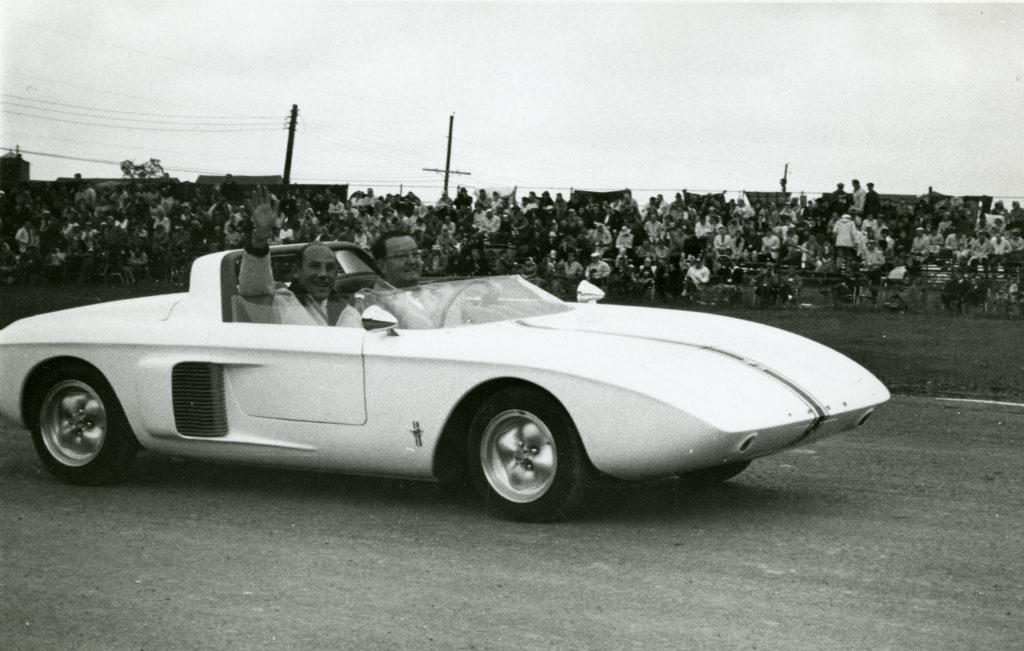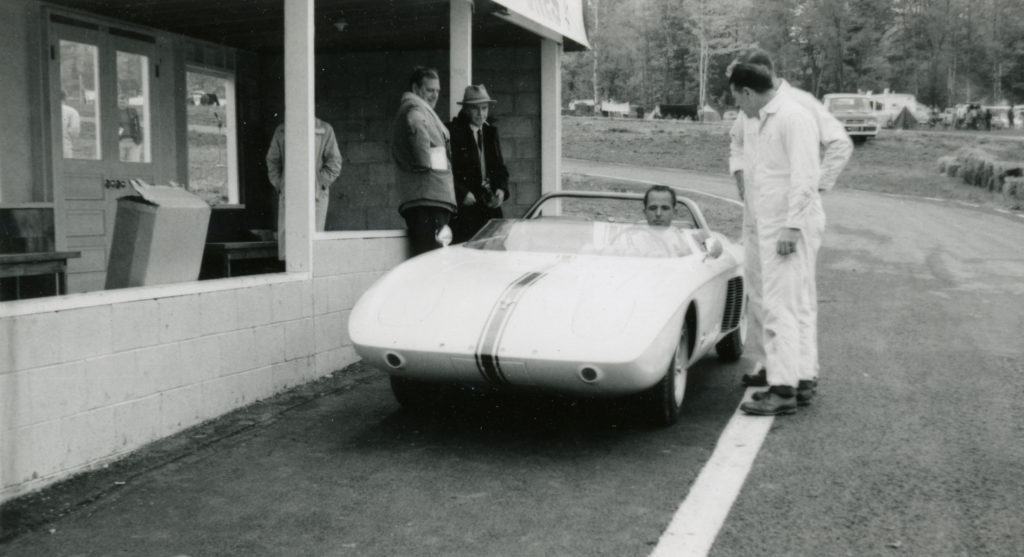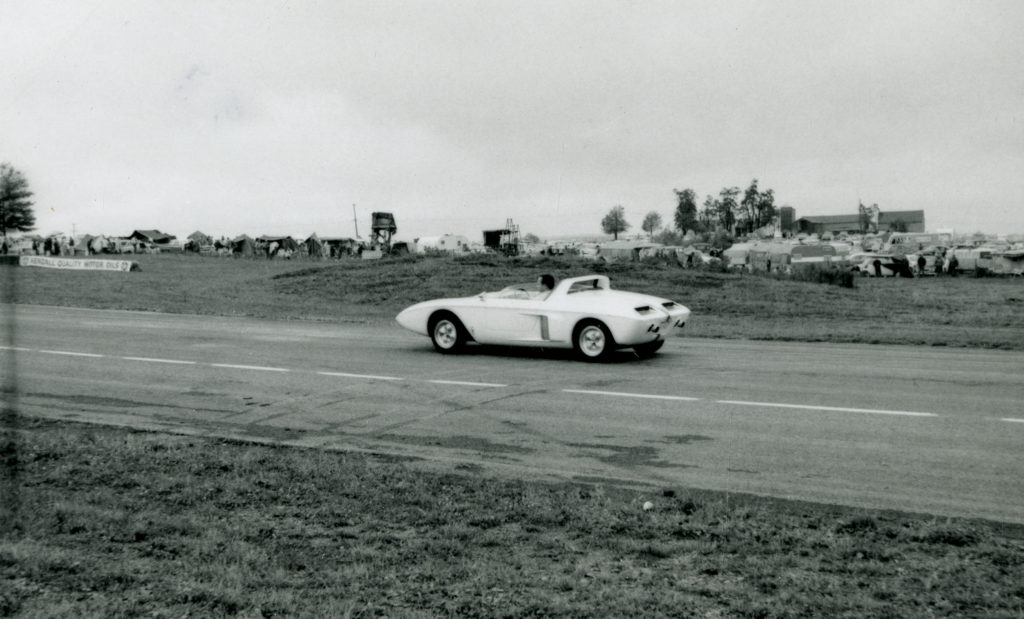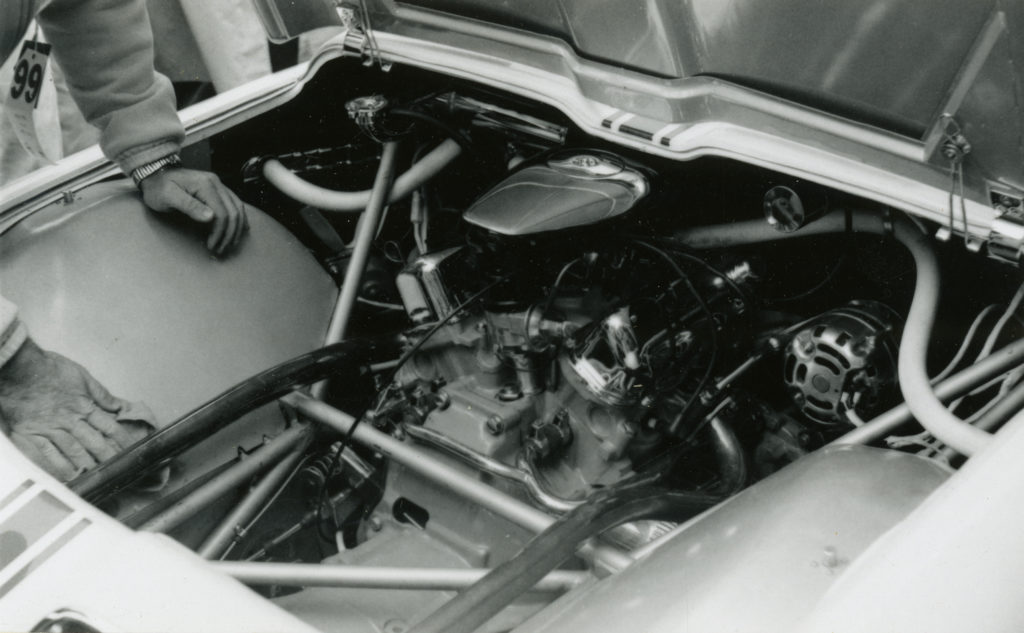This year’s Grand Prix Festival in Watkins Glen honors Mustang, the original American “pony car.” Ford Motor Company developed the experimental version of the Mustang in 1962 to test new innovations in design and styling, later producing the wildly successful street car that would carry the name and the model’s popularity through almost six decades.
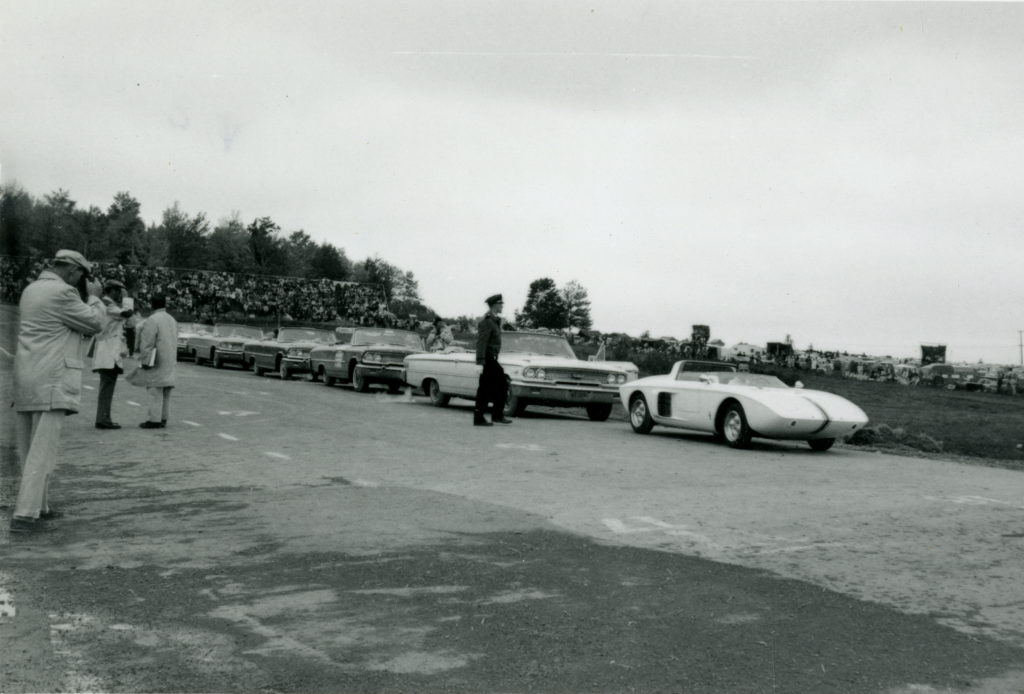
The new Ford Mustang prototype leads the Drivers’ Parade of Honor at the United States Grand Prix at Watkins Glen in 1962.
Ford introduced the two-seater, prototype Mustang roadster at the United States Grand Prix in October of 1962. The accompanying photographs from the Bill & Ginny Close collection in the Center’s archive depict the new Mustang leading the drivers’ parade, in the pits, and on the track. One shows the 60-degree, mid-mounted V-4 1500cc Cardinal engine with four-speed transaxle. Course marshal Charles Lytle with Sir Stirling Moss, the race’s honorary starter, riding shotgun, led the parade of Ford Galaxies carrying Formula One drivers from around the world. Popular racer Dan Gurney put the Mustang through its paces on the road course, showing off the design and performance while achieving speeds of over 100 m.p.h., in a non-competitive demonstration drive.
The prototype’s development by a talented group of company engineers and stylists marked Ford’s renewed interest in racing and performance. Its debut heralded the success of Ford’s “Total Performance” program, a commitment of corporate resources to motorsports competition that would allow the manufacturer to dominate racing in the 1960s. It tested the feasibility of an affordable, sportier car in a growing market of eager, young buyers.
The fully-functional, hand-built prototype or Mustang I varied greatly from later models. The “startling,” one-of-a-kind sportscar was fabricated by Troutman & Barnes, a race car shop in Culver City, California. Weighing in at 1200 pounds, it was aluminum bodied, tube framed, with an independent suspension, front disk brakes, and a 90-inch wheelbase. It had a built-in roll bar and 13-inch cast magnesium wheels. It was liveried in American racing colors of blue and white, with the famous running pony emblem on the hood.
This Ford Motor Company film about the creation of the prototype narrates the process from the drawing of the original design, constructing the frame, showing the body as it is sculpted in clay and fabricated in fiberglass and aluminum, through the testing process, and its public debut at Watkins Glen. Bill France Sr. makes a cameo appearance watching the Mustang’s run at Daytona.
The original prototype is preserved as part of the automobile collection at the Henry Ford Museum in Dearborn, Michigan.
Ford Motor Company partnered with the Watkins Glen Grand Prix Corporation, the track’s managers, from the first Formula One race in 1961. The Glen was used as a venue for publicity events for the manufacturer. The Mustang II, a 4-seater concept car, debuted at the United States Grand Prix in 1963, the year after the experimental version was first introduced. Mustang was the official car of the Glen from 1964 to 1967, with 23 Mustangs made available for the use of Formula One teams during their visits. Mustangs paced races at Watkins and the Indianapolis 500.
The production model, four-seater Mustang coupe launched in April 1964 at the New York World’s Fair sold 1 million cars in less than two years, the most successful launch for Ford since the Model A in 1927. They were the hottest thing around and virtually unobtainable the first summer with as much as a 3-month backlog on orders. Initial research revealed more than half of Mustang buyers in 1964 were between 20 and 34 years of age and 40% made $5000 to $10,000 per year at a time when the median family income in the United States was $6,600. With the launch of the Mustang, Ford successfully targeted a younger, single, female demographic, providing an affordable, compact coupe with style and performance.
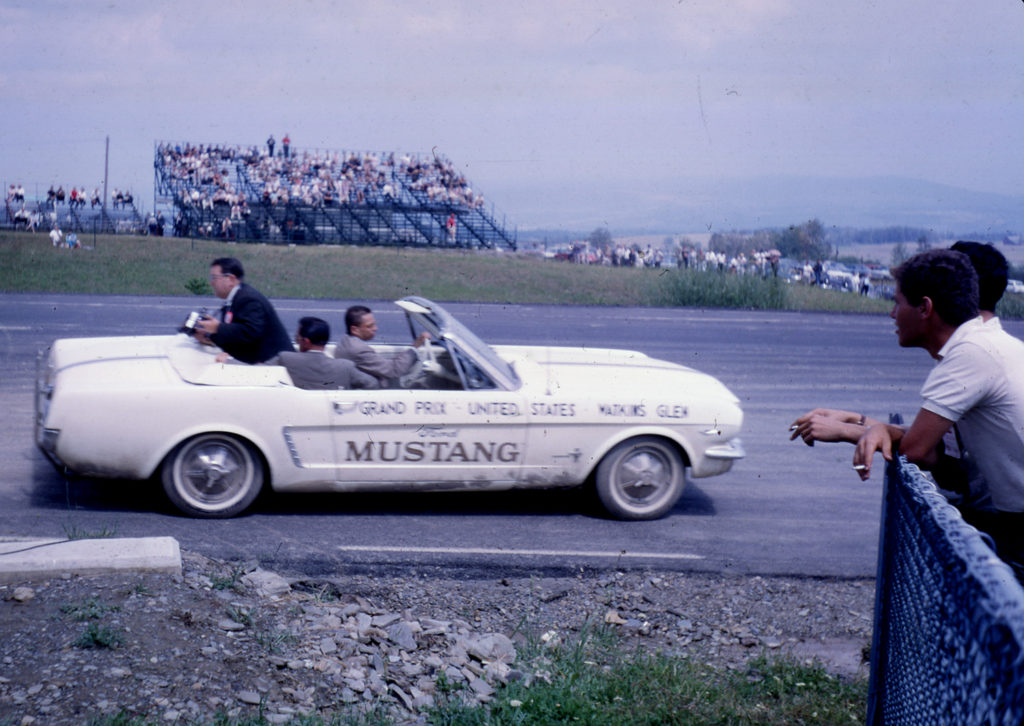
Driven by Cameron Argetsinger, this 1964 Mustang served as the official pace car during the Glen 500 and other local races.
Come to the Festival to celebrate Mustangs of all eras. Enjoy the appealing personality of the early models described by the manufacturer as “demure enough for church-going, racy enough for the dragstrip, modish enough for the country club.”
The first purpose-built, closed-course, road circuit at Watkins Glen, opened on a glorious, chilly autumn weekend in mid-September 1956, welcoming 118 racers to compete in six race events during the 9th Annual International Sports Car Grand Prix. The circuit, which has since hosted nearly every major racing series over more than six decades, almost did not open at all.
The efforts by the Watkins Glen Grand Prix Corporation – up to the 11th hour – to ready the 2.3-mile track in time for the race weekend were extraordinary. A successful “wave the green fag” bond campaign in the local community raised initial start-up funds for the project in a single month. Contractors broke ground in late July and, after delays caused by heavy rains and unfavorable weather, completed the final touches on the asphalt paving only an hour before practice sessions began. Alterations to one of the curves, using earth-moving equipment under the glare of spotlights, were made during the night before the first race. And then officials from the Sports Car Club of America jeopardized the entre event by withdrawing their recommendation for members to participate at the last minute due to what they deemed the “serious and hazardous conditions of the course.”
Despite official concerns, not a single driver willingly withdrew from competition. A crowd exceeding 30,000 spectators enjoyed the “European carnival aspects” of the weekend and watched a “thrilling race” across the fast and tricky course as George Constantine of Sturbridge, Massachusetts in his D-Type Jaguar took the checkered fag for the Sports Car Grand Prix.
The IMRRC
With a mission to “To collect, preserve and share the global history of motorsports,” The International Motor Racing Research Center, located at Watkin’s Glen, New York, has, since 1996, been a place open to historians and to the general public and preserves an ever-growing collection that documents the history of racing in the more than 4000 books, 250 different motorsports magazines and newspaper titles, club and sanctioning body records, race results, programs and posters, papers of motorsports journalists and scholars, correspondence of race organizers and still and moving images. Its knowledgeable research and archives staff assists hundreds of scholars, journalists, authors, documentary film makers, drivers and race car owners from all over the globe with inquiries about motorsports history every year. It relies on gifs and donations from the motor sport community. See www.racingarchives.org.
Download the Original Article.
Kathie J. Meredith photographed Austrian racer Jochen Rindt immediately after he took the checkered flag in the 1969 United States Grand Prix at Watkins Glen International. Rindt, still behind the wheel of the red and gold Lotus-Ford, had just secured his first Grand Prix victory after a frustrating, five-year chase. While Rindt nabbed the headlines, Meredith explored the many other stories of the race weekend—Bruce McLaren blowing his engine, unpleasant weather, the arrival of a reluctant poodle, young campers collecting firewood and
mechanics working in the pits. Meredith captured and shared the many moods of the Grand Prix at Watkins Glen.
As a newly-hired reporter, Meredith took her notebook and cameras to her first race at Watkins Glen International in the Summer of 1968. A native of Indianapolis, home of the Indy 500, Meredith knew racing and race drivers from days at the Speedway with her mother Geneva. Meredith covered races at Watkins Glen during one of the most exciting eras in the circuit’s history, when it hosted major national racing events as well as top-level international races including the prestigious Formula One series. Meredith focused her lens on big stars and small occurrences. Meredith’s Press Pass gave her up-close access to stars of the motorsports world. Her intimate portraits captured the intense emotion of the drivers in the cockpit and pit row. In addition to driver portraits, she photographed what happened behind the scenes…scorers recording lap times, team members, the safety crew and fans bundled up against the October chill, drinking beer and watching the races. She shared the latest innovations, engineering and design of race cars along with views of the new Watkins Glen pit area. Her photographs reflect her keen eye.
During her 40-year career as a regional editor, writer and photographer at the Daily Messenger newspaper in Canandaigua, NY, Meredith’s focus was always on people. She was a perfect fit at a local newspaper. She reported on everything from politics to festivals to local theatrical productions. Her press access allowed her to promote local artists and musicians, interview celebrities, cover presidential inaugurations and even report on the second moon launch. Her skills as a photojournalist displayed the heart and great variety of activities in her community; people selling grapes, protesting the Vietnam war and watching races at Watkins Glen.
Reflecting on her career at her retirement in 2008, Meredith said, “I have been really, really fortunate just to be able to tell stories.” The Trackside Stories exhibition of Meredith’s photographs is part of a larger project undertaken by the International Motor Racing Research Center (IMRRC) in 2020 to celebrate the contributions of women to motorsports. This display reflects the theme of women “behind the lens” focusing attention on women photographers. Launched to coincide with the Centennial of American women’s suffrage, the project explores the experiences of pioneering and current women drivers “behind the wheel” as well as the role women have played “behind the scenes” in organizing races, overseeing timing and scoring, managing race tracks, owning teams, improving safety and engineering racecars.
Opening later this year, IMRRC will present the primary exhibition “Women of Speed: Legacies in Motorsports” at its Visitors Center, 610 South Decatur, Watkins Glen, New York.
Smaller complementary displays will be in satellite locations throughout the village, including the Watkins Glen Chamber of Commerce Visitors Center at 214 North Franklin Street.
The theme of women in racing will also be reflected in IMRRC’s regular lecture series “Center Conversations” with free public programs featuring prominent women in the auto industry. Visit the Center’s upcoming event page for more information: www.racingarchives.org/exhibitions/.


